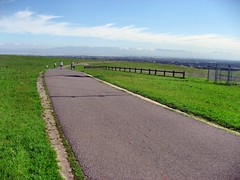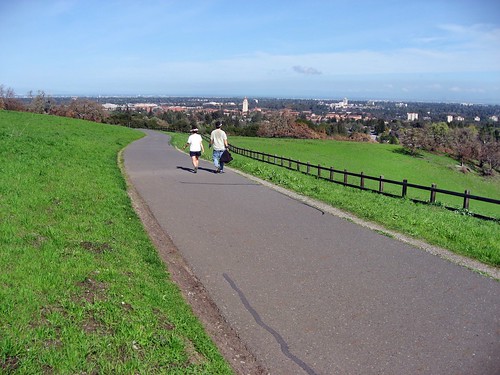After weeks of driving to San Francisco for long runs across the Golden Gate Bridge and into the Marin Headlands, I returned to a favorite venue: the Stanford University campus.
Stanford’s land is vast – its 8180 acres include 2300 acres of lovely tree-lined streets on the main campus and 2500 acres of open land in the foothills. Plenty of room to run for hours.
My legs were beaten-up from speedwork and stiff-legged deadlifts, and I resolved to go slowly and do only what my body suggested, speaking through the inner voice of the heart.
I made a wide loop past the Medical Center, then wandered by the lake and into the hills. Near the top of the hills I began taking pictures – the hills are lovely at this time of year. (Photo: “The Dish” radio telescope, a familiar Peninsula landmark)
Shortly before the last rise, I sped up spontaneously – no debate over whether I “ought to” – I simply hot-footed it for 100 yards. It made a nice break from long-run pace.
But speeding up made me aware of my convalescent legs, and I jogged easily to the top of the hills. I stopped and looked around, ate a Clif Gel and drank water, then resumed trotting down the lovely road.
I thought to take photos of this part of the route while the hills are green, to replace some lousy pix in my Flickr collection.
During the run, I’d been picking up trash and putting it in a freezer bag. In places where people hike or run, the trailside trash is invariably 90 percent Kleenex. And, frankly, runners of the male persuasion don’t carry Kleenex, but clear their sinuses by holding finger to nose and blowing vigorously. (Cf. fullback Tom Rathman of the San Francisco 49ers, as captured clearing his sinuses on TV in the late 1980s. John Madden: “Yeah, you take Tom Rathman — now, he’s got all the qualities of the classic fullback. Gosh, he’s even from Nebraska, where they breed fullbacks.” Camera obligingly pans to Rathman, who responds with the classic snort.)
I visualize [persons of a sex which I will graciously omit to mention] daintily blowing their noses and thinking, “Ooo – ick! I know it’s karma, but no way I’m gonna carry that.”
God does know how much the icky-ooers irk me. On trails in the Coastal Range, I once followed in the footsteps of a deranged ickster who’d strewn Kleenex every 50 yards. It was so over the top that I could only laugh.
 At any rate, I was feeling notably un-bugged while picking up after the animals, and on the long, swooping descent, my mood was positively playful. I paused to take a picture, then jogged across the road to pick up a Kleenex, making a game of it. My energy had spritzed up nicely; I wasn’t sure why, but after the run I reflected that it was the short sprint that did it. Energy begets energy. (Photo: start of the descent toward the Stanford Avenue gate)
At any rate, I was feeling notably un-bugged while picking up after the animals, and on the long, swooping descent, my mood was positively playful. I paused to take a picture, then jogged across the road to pick up a Kleenex, making a game of it. My energy had spritzed up nicely; I wasn’t sure why, but after the run I reflected that it was the short sprint that did it. Energy begets energy. (Photo: start of the descent toward the Stanford Avenue gate)
Training that’s based on carefully managing energy is rewarding. Enthusiasm, good feelings, and joy are nature’s way of telling us “This body is getting exactly the exercise it needs.” Expansive exercise always delivers those good feelings. Contraction, on the other hand, produces suffering. And nothing’s more contractive than overtraining.
Grim determination has its place. Long races like marathons and ultras are always a crapshoot. You can never know what gremlins will reach up out of the ground and grab your ankle late in the race. It’s part of the game, testing yourself against the inevitable “bad patches,” and refusing to quit. That kind of victory isn’t physically expansive, because the body doesn’t “get better” by beating it to a pulp – but it can be rich with meaning at the level of the heart and spirit.
Watching videos of the Eco-Challenge, I notice that the winning teams manage to sustain an aura of positiveness. And in a video of the Navy Seals “Hell Week” — the grueling seven-day test of Seal candidates’ physical, mental, and emotional mettle — a Seal instructor remarks that the quality that sets the “winners” apart isn’t physical strength, but the ability to let go of self-identifications and broaden one’s identity to include the team.
I wonder if training ever has to be grim. Training is where we gather energy for the big tests. And beating up the body doesn’t improve fitness, nearly as well as working with the body, pushing it no farther than it can improve and recover, “playing the edges” in a way that leaves our bodies with the resources to grow stronger.
When I started out as a runner, I had some naïve ideas about how running works. I started running at the suggestion of a senior monk of a spiritual organization that I belonged to. He said, “The thought occurs that you might not be getting enough exercise.”
It was 1968 and I was living in Southern California, near the ocean. Even in that hotbed of sports you hardly ever saw a runner in those days. So I wondered what to do. I prayed for guidance, and the next morning my supervisor walked up, eyes agleam, and pressed a book in my hands. “George,” he said, “You’ve got to read this book. I’ve been following this system for six months and it’s done wonders for me.” It was the first edition of Kenneth Cooper’s Aerobics.
I had recently recovered from being paralyzed from the chest down for 2½ years. A tumor had compressed my spine in the area of the heart, and although I was able to walk and jog, the damage to my spinal cord made it difficult to harmonize my feelings. Still, on my best runs, I experienced an inner harmony and happiness.
I had read a book about a 19th-century Bengali saint, Sri Ramakrishna, in which he was quoted as saying that a person who wants to achieve inner bliss should overcome laziness with vigorous activity, then overcome restless energy with calm discrimination and inner poise.
I wondered if this was the key to those rare, wonderful experiences when I ran. I began starting each run with a hard effort, thinking that once my energy got rolling, I could “back off” and find a calm center within. But it never worked.
Starting fast helped me shake off a lazy mood on occasion, but it never brought the experience of the “zone” that I was looking for – that wonderful state where high energy and calm focus blend in an blissful flow. (Photo: View of the Stanford campus from the descent toward Stanford Avenue)

Over time, I learned that running well and finding joy isn’t about following rigid systems. Instead, it requires learning to listen to the body. And I realized that the body was constantly telling me of its needs through the feelings of the heart. If I speeded up prematurely at the start of a run, my heart would feel, on a subtle level, unhappy, disharmonious, and disturbed. But if I warmed up gradually, I would often be able to find my way into the zone.
The discipline of listening to the heart paid off richly. I’m sure that my case is unique, because the effects of the paralysis and surgeries linger, and it’s still a struggle to harmonize my heart. But the principles are true, and they just need to be applied individually. Most people probably don’t require as long a warmup as I do.
On Saturday at Stanford, I found a lovely flow of energy by cutting through the pleasant humdrum of the long run with a spontaneous burst of energy. The result was an enjoyable, happy, expansive state. Trivial, no doubt – happily picking up the trash isn’t saving the world or finding enlightenment – but it was deeply enjoyable for me. To paraphrase Gandhi, “The small acts that we do are not significant in themselves, but it is important that we do them.”
I believe we can boil all of training down to a simple principle: “expansion equals joy.” And its corollary: “contraction equals sorrow.” The trick, in training, is to know which acts will prove expansive. And way to know is by listening to the intuitive feelings of the heart, because the heart is wise in these matters.
